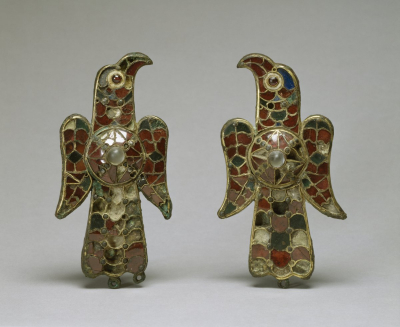The Sack of Rome on 24 August 410 AD was undertaken by the Visigoths led by their king, Alaric. At that time, Rome was no longer the capital of the Western Roman Empire, having been replaced in that position first by Mediolanum in 286 and then by Ravenna in 402. Nevertheless, the city of Rome retained a paramount position as "the eternal city" and a spiritual center of the Empire. This was the first time in almost 800 years that Rome had fallen to a foreign enemy, and the sack was a major shock to contemporaries, friends and foes of the Empire alike.
The sacking of 410 is seen as a major landmark in the fall of the Western Roman Empire. St. Jerome, living in Bethlehem at the time, wrote; "the city which had taken the whole world was itself taken."
The Visigoths (; Latin: Visigothi, Wisigothi, Vesi, Visi, Wesi, Wisi) were an early Germanic people who, along with the Ostrogoths, constituted the two major political entities of the Goths within the Roman Empire in late antiquity, or what is known as the Migration Period. The Visigoths emerged from earlier Gothic groups, including a large group of Thervingi, who had moved into the Roman Empire beginning in 376 and had played a major role in defeating the Romans at the Battle of Adrianople in 378. Relations between the Romans and the Visigoths were variable, alternately warring with one another and making treaties when convenient. Under their first leader, Alaric I, the Visigoths invaded Italy and sacked Rome in August 410. Afterwards, they began settling down, first in southern Gaul and eventually in Hispania, where they founded the Visigothic Kingdom and maintained a presence from the fifth to the 8th centuries AD.The Visigoths first settled in southern Gaul as foederati to the Romans, a relationship that was established in 418. However, they soon fell out with their Roman hosts (for reasons that are now obscure) and established their own kingdom with its capital at Toulouse. They next extended their authority into Hispania at the expense of the Suebi and Vandals. In 507, however, their rule in Gaul was ended by the Franks under Clovis I, who defeated them in the Battle of Vouillé. After that, the Visigoth kingdom was limited to Hispania, and they never again held territory north of the Pyrenees other than Septimania. An elite group of Visigoths came to dominate the governance of that region at the expense of those who had previously ruled there, particularly in the Byzantine province of Spania and the Kingdom of the Suebi.
In or around 589, the Visigoths under Reccared I converted from Arianism to Nicene Christianity, gradually adopting the culture of their Hispano-Roman subjects. Their legal code, the Visigothic Code (completed in 654), abolished the longstanding practice of applying different laws for Romans and Visigoths. Once legal distinctions were no longer being made between Romani and Gothi, they became known collectively as Hispani. In the century that followed, the region was dominated by the Councils of Toledo and the episcopacy. Little else is known about the Visigoths' history during the 7th century, since records are relatively sparse. In 711, an invading force of Arabs and Berbers defeated the Visigoths in the Battle of Guadalete. The Visigoth king, Roderic, and many members of their governing elite were killed, and their kingdom rapidly collapsed. This was followed by the subsequent formation of the Kingdom of Asturias in northern Spain and the beginning of the Reconquista by Christian troops under Pelagius.During their governance of Hispania, the Visigoths built several churches that survived. They also left many artifacts which have been discovered in increasing numbers by archaeologists in recent years. The Treasure of Guarrazar of votive crowns and crosses are the most spectacular. They founded the only new cities in western Europe from the fall of the Western half of the Roman Empire until the rise of the Carolingian dynasty. Many Visigothic names are still in use in modern Spanish and Portuguese languages. Their most notable legacy, however, was the Visigothic Code, which served, among other things, as the basis for court procedure in most of Christian Iberia until the Late Middle Ages, centuries after the demise of the kingdom.

 English
English  español
español  français
français  português
português  русский
русский  العربية
العربية  简体中文
简体中文 
